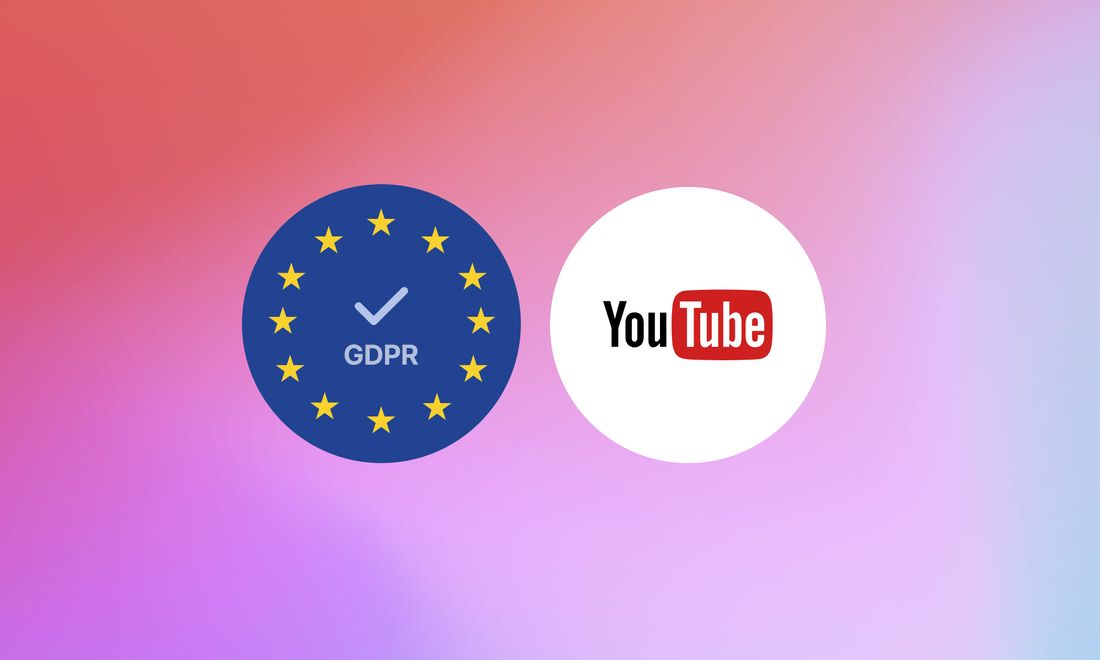
YouTube ("Nocookies") GDPR-Compliant Integration: The Ultimate Guide
YouTube has become the gold standard for video content, with almost every company maintaining an account and leveraging the platform for uploading and distributing videos. Naturally, it seems practical to also use these videos directly on your own website. Why not? YouTube is free compared to other platforms, has a reliable player, and delivers excellent video quality.
In this guide, we’ll take a closer look at integrating YouTube videos into your website. This process can often pose challenges—especially when complying with data protection laws like the GDPR in Europe.
YouTube offers a "nocookies" mode, which seems like a privacy-friendly option. However, it’s worth taking a closer look at its limitations and potential pitfalls.
Here’s the quick summary:
- Yes, YouTube can be GDPR-compliant, as long as you follow certain rules (outlined below) and obtain explicit consent from your visitors. This can be done either via a cookie banner or a two-click solution.
- No, you cannot simply use the YouTube-NoCookie option. Even this requires explicit consent through a cookie banner or a two-click solution.
- If you want your meticulously produced videos to be seen on your own website, YouTube is not the best option. Use a video hosting service based in Europe that avoids cookies.
Now, let’s dive into the details:
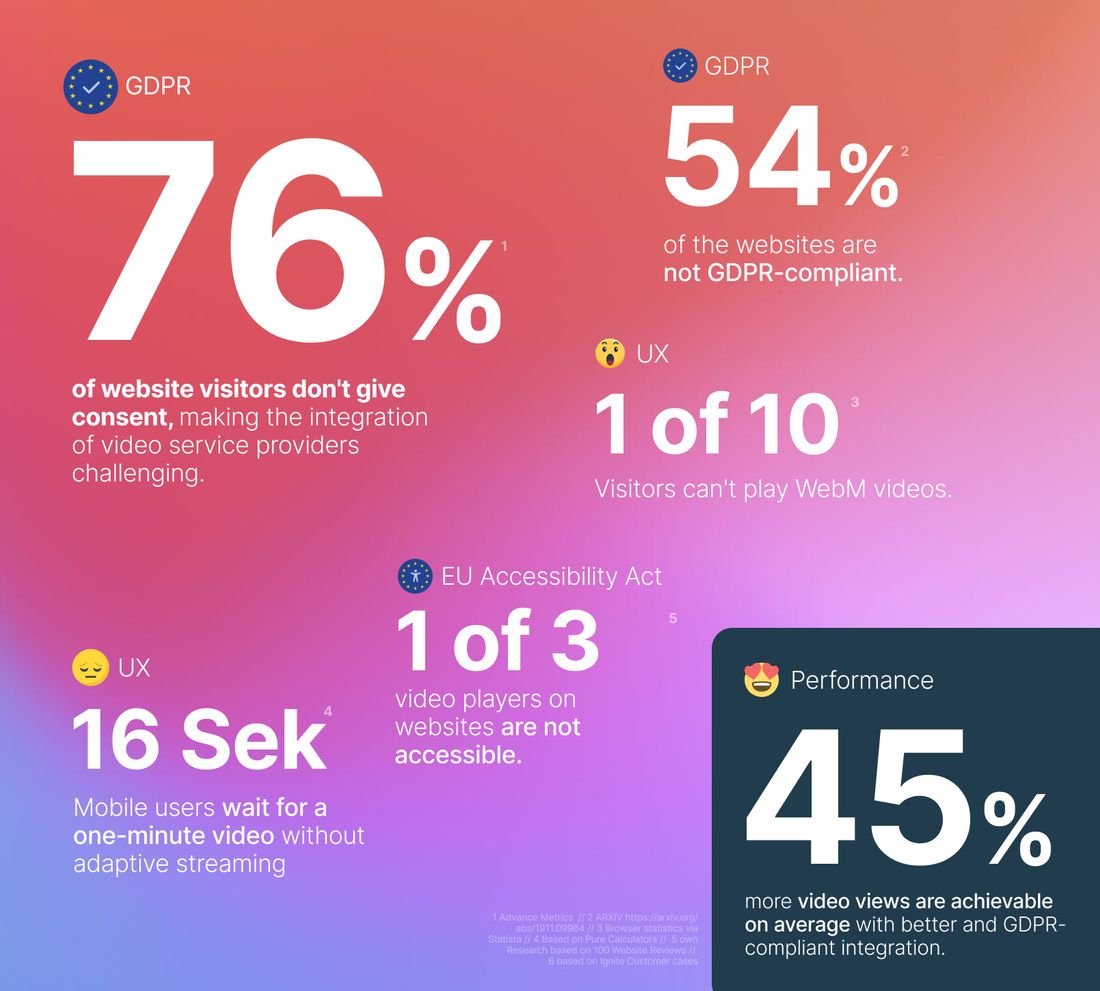
Why YouTube is a Challenge for GDPR Compliance
YouTube is incredibly convenient. In theory, you just upload a video, copy the code, embed it on your website, and you’re done. In theory.
However, GDPR complicates things for you. This is due to several factors:
- Tracking of Personal Data: YouTube collects data on user behavior as soon as a video is embedded on your website—even if the video is not played. As a subsidiary of Google/Alphabet, YouTube uses this data to create advertising profiles of your visitors. Example: If you’re a provider of product XY and embed a related video on your website, YouTube/Google now knows your visitors are interested in that product. They can use this information to deliver targeted ads—even from your competitors.
- Data Transfer to the USA: YouTube stores and processes data on servers worldwide, including in the USA. Even with certification under the EU-U.S. Data Privacy Framework, legal risks remain. There’s no guarantee that data will be hosted exclusively within the EU.
- Use of Cookies Without Consent: By default, YouTube sets cookies that violate GDPR unless explicit user consent is obtained. The "nocookies" mode doesn’t fully resolve this issue (details below).
- Not an "Essential Service" and Consent is Required: According to data protection experts, YouTube does not qualify as an essential service. In most cases, embedding videos on your website is optional and thus requires explicit consent from your users.
What the Experts Say:
“Without additional data protection measures to obtain your users’ consent for data collection by YouTube, embedding YouTube videos is not GDPR-compliant.” (Quote is translated from German. Source: e-Recht24)
Quick Disclaimer: The level of risk associated with YouTube integration must always be assessed by your data protection officer. We can only provide a non-binding recommendation here.
Note: These issues only apply if you want to embed videos on your website. If your customers visit your YouTube channel directly, YouTube is responsible for GDPR compliance. However, your channel still needs elements like an imprint and other legal information.
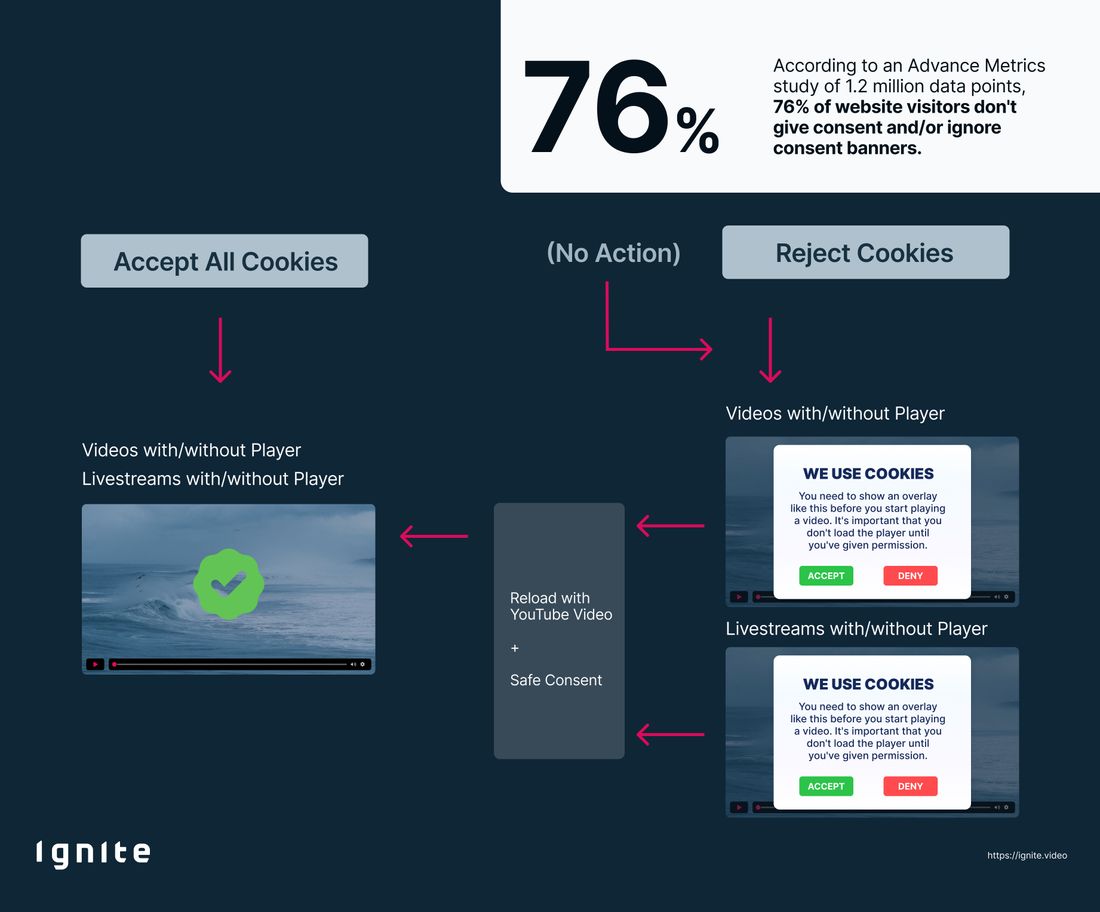
Legal Requirements You Must Implement
If you embed YouTube videos on your website, you need to ensure compliance with all legal regulations. Here are the key requirements:
- Obtain Consent: GDPR requires clear user consent before tracking or data transfers can occur. A cookie banner is therefore essential.
- Update Your Privacy Policy: Website operators must clearly state what data is collected through YouTube and how it is processed. This must also be addressed specifically for YouTube videos. A template for this can be found here.
- Implement a Two-Click Solution: Videos must only load after explicit user consent. This minimizes legal risks and ensures greater transparency. As previously mentioned, this also applies to the "NoCookie" version in enhanced privacy mode, which we will discuss later.
Key Point: You may only display a video after explicit consent has been obtained. A click on "Play" does not constitute consent.
Simply embedding the video without these precautions is not compliant, and you’ll need to address all these requirements.
This is true not only for YouTube but also for Vimeo and GDPR compliance. Vimeo offers a privacy-focused mode, but it similarly fails to fully address GDPR requirements. There are alternatives, which we will explore later. But first, let’s take a closer look at YouTube's enhanced privacy mode:
What is YouTube-Nocookie / the Enhanced Privacy Mode?
Recognizing the privacy concerns, YouTube offers an “Enhanced Privacy Mode” for embedding videos on websites. Here’s how it works:
- Click on Share below your video.
- Select Embed from the options.
- Scroll down slightly, and you’ll find the option to enable enhanced privacy.
When you activate this mode, the embedded videos are loaded from YouTube-NoCookie.com instead of the standard YouTube domain.
This approach aims to reduce the amount of data collected during the initial loading of the video. However, as we’ll discuss later, this mode doesn’t entirely eliminate GDPR compliance issues.
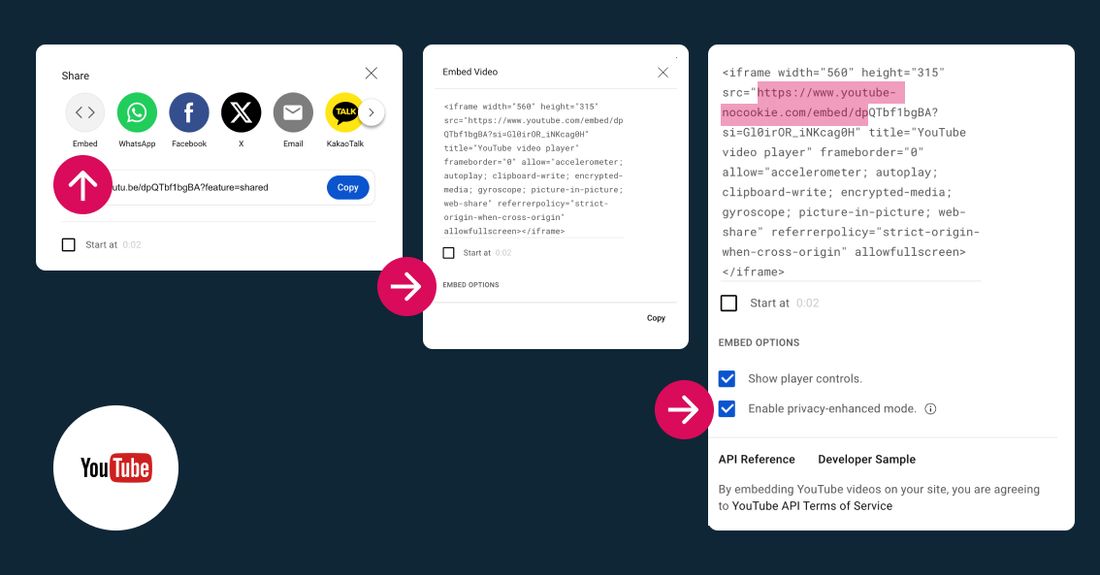
The nocookies mode on YouTube appears to offer a simple way to embed videos in a more privacy-friendly manner. The main advantages are:
- No cookies in the preview: Videos can be embedded without initial tracking, as long as they’re not played.
- Easy to implement: This mode requires just a minor adjustment to the embed code or one click during setup. However, YouTube doesn’t save this selection—you’ll need to adjust it for every video individually.
- Minimal effort for you: No complex technical solutions are necessary.
However, these advantages alone are not enough to fully meet GDPR requirements.
The GDPR Issues with YouTube-Nocookie
Here’s what Datenschutz.org has to say about the nocookies solution:
“Using YouTube Nocookie only prevents the transfer of personal data to third parties (e.g., ad services). YouTube cookies still collect some user data and transfer it to specific Google servers—even before the embedded video is played. Therefore, simply using YouTube Nocookie on your website is not entirely GDPR-compliant.” (This quote is translated from German. Source: Datenschutz.org)
Let’s Break It Down:
- There are typically two main reasons why you might want to use the nocookies version:
- You care about privacy and want to provide a better experience for your website visitors.
Let’s be honest: if that’s your motivation, Google/YouTube is the wrong choice. You’re aligning yourself with “Big Tech,” a massive data machine. That’s not winning you any privacy points.
You don’t want to hide your videos behind a consent banner because it’s important to you that people see them.
Unfortunately, YouTube-Nocookie doesn’t solve this problem. While fewer cookies are set, it doesn’t eliminate them entirely. The risks remain the same.
What Actually Happens?
- Step 1: The YouTube video preview is loaded onto your website, and no cookies are set at this point. This part doesn’t require user consent. Great!
- Step 2: As soon as someone wants to watch the video and clicks “Play,” personal data is sent to YouTube. Oops! This action requires user consent.
The Bottom Line
You gain nothing significant. Yes, it can technically be GDPR-compliant if you implement proper consent mechanisms. No, it’s not an ideal solution for embedding videos on your corporate website. If privacy matters or you want seamless video visibility, this isn’t the right path.
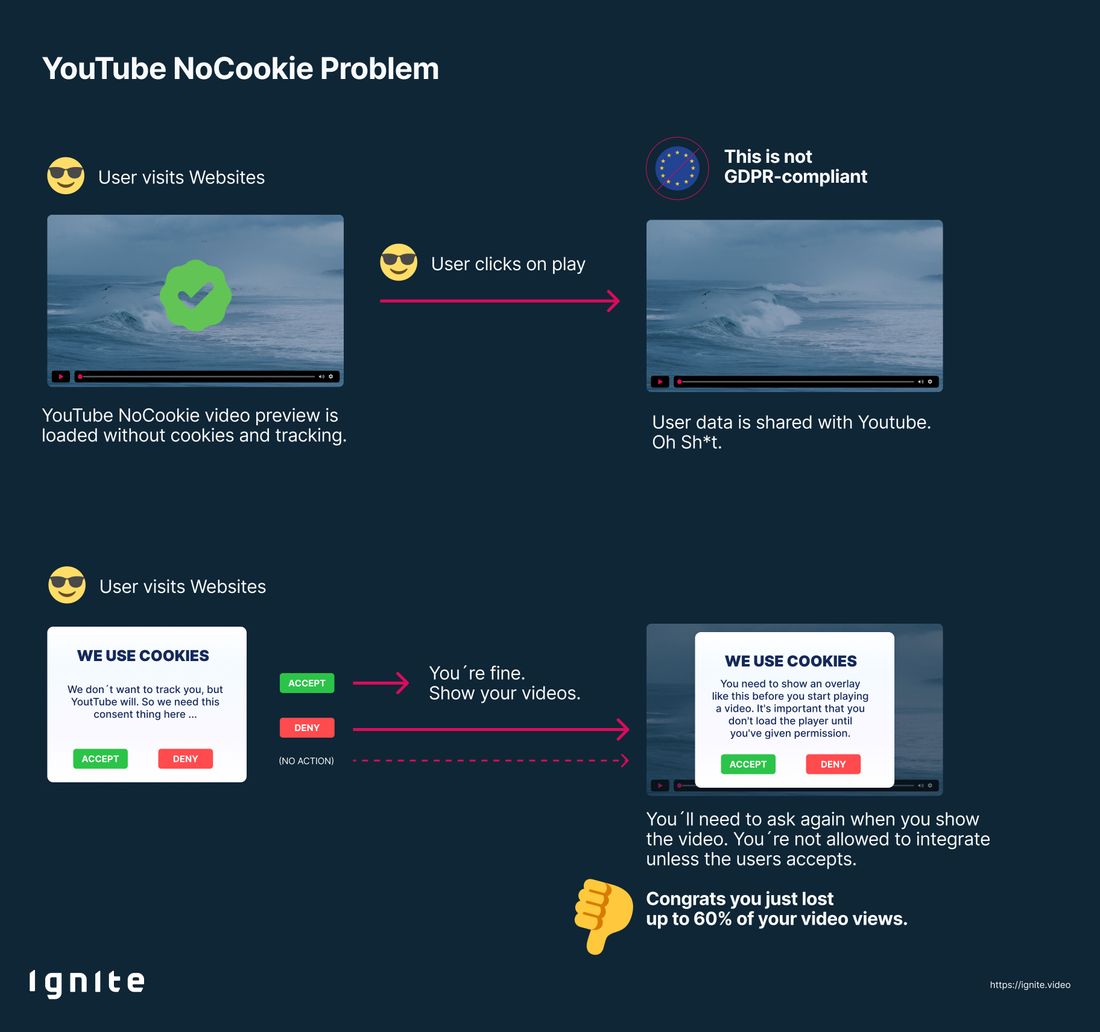
Checklist: Options for Embedding YouTube Videos in a Privacy-Friendly Way
As you can see, it’s complicated. To help minimize legal risks, here’s a quick overview of the most important options.
Absolute Basics:
- Update your privacy policy: No matter what, include YouTube in your privacy policy.
- Obtain explicit consent: Never play YouTube videos without user consent. A cookie banner is absolutely essential.
Practical Options:
A. Use the “NoCookie” Parameter
With the “NoCookie” option, YouTube videos are embedded in a way that no cookies are set during the preview. This is generally a good starting point.
However, proceed with caution: Once the video is played, YouTube tracking cookies are set, which still requires explicit user consent.
Recommendation: Even with user consent, using this option is a smart idea as it reduces the amount of data shared with YouTube. Definitely recommended.
B. Implement a Two-Click Solution
Videos are only loaded after explicit user consent. Instead, users see a preview image with a prompt like “Show Video” or “Consent Required.”
Technical Implementation: Various plugins for WordPress or other CMSs, such as “Complianz” or “Borlabs Cookie”, make this easy to set up. These plugins block YouTube videos by default and load them only after consent.
Important: Videos must only load after consent. With standard embedding, data is often transmitted even before the video is played.
C. Use Links Instead of Embedding
Instead of embedding YouTube videos directly on your website, you can provide them as external links. This method prevents any data from being sent to YouTube unless users actively click the link.
Drawback: This approach is less user-friendly and may feel less professional.
Final Note
Each of these options has its pros and cons. However, combining the “NoCookie” parameter with a two-click solution is often the best compromise between usability and GDPR compliance.
Honestly, None of This is Great: Are There Alternatives?
Videos that are only shown to a portion of your visitors or require multiple clicks to play will cost you views. That’s unfortunate, especially since videos are typically expensive and time-consuming to produce.
To be honest, you’ll face the same issues with all major providers—mostly from the US. Embedding Vimeo or Wistia videos GDPR-compliantly is the same headache. With every platform, you’ll need to hide your videos behind consent banners. It’s no easy task when it comes to meeting data protection requirements in Germany and the EU.
Three Alternatives
1. Self-Hosting
This solution gives you maximum control over your data.
Challenges: While it offers full ownership, it’s not scalable or performance-optimized. Adaptive streaming—crucial for the growing mobile web usage—is usually missing.
Additionally, you’ll need to address issues like player accessibility on your own.
2. Own Video CDN
Setting up your own dedicated video servers is a premium solution for large-scale websites.
Drawbacks: It’s expensive to set up and maintain, requiring significant investment in both infrastructure and expertise.

3. Ignite Video
We’ll be honest—we’ve used services like YouTube on our websites in the past, and the associated privacy issues drove us crazy. Why isn’t there a simple way to embed videos with copy-and-paste ease, without the GDPR hassle?
When 30–60% of visitors can’t view your videos because of consent requirements? No way. That’s why we created Ignite Video:
- Privacy First: Everything is hosted in Europe (Germany).
- No User Tracking: Your visitors’ data stays private.
- No Cookies or Consent Required: Say goodbye to banners and overlays.
- Autoplay-Friendly: Videos start seamlessly without restrictions.
- Barrier-Free Player: Fully accessible and compliant.
- No Ads or Recommendations: Just your content, exactly as intended.
With Ignite Video, you simply upload your videos and embed them into your website. All you need to do is mention us in your privacy policy. That’s it—it’s copy-paste, just like YouTube, but without the GDPR headaches.
Why settle for complicated workarounds when you can have a solution that just works ... no GDPR bullsh*t?
Conclusion: If You Want Visitors to Watch Your Videos, YouTube Is Not an Option
YouTube’s nocookies mode is a step in the right direction, but it’s not enough to fully comply with GDPR requirements. Website operators must implement comprehensive consent solutions and explore alternatives to minimize legal risks.
But Won’t My YouTube Video Get Fewer Views?
Yes, that’s true. But what matters more to you? Increasing your view count on YouTube or ensuring that people actually watch your videos? Most likely, the latter.
- This doesn’t mean you should stop uploading videos to YouTube altogether—no one, not even the GDPR, is taking that away from you.
- It simply means that as soon as you embed a video on your website, YouTube becomes one of the worst options.
And let’s face it: two-click solutions are a nightmare for user experience.
If you truly care about delivering great video experiences and staying GDPR-compliant, consider other options that prioritize privacy and ease of use.
FAQ: YouTube, GDPR and Website Embeds – What You Really Need to Know
Here's what companies ask most often:
Is embedding YouTube videos GDPR-compliant?
Only with proper consent. YouTube collects personal data and sets cookies – even with the NoCookie mode – which means: no consent, no video. A consent banner or a two-click solution is mandatory.
Does the YouTube NoCookie mode make embedding videos safe?
Not entirely. NoCookie changes the domain and limits some data sharing, but it doesn’t eliminate all tracking. Once someone clicks play, data is still transferred to Google. You still need user consent. Ignite Video is a good alternative.
Can I just use a two-click solution and be fine?
Yes – if it’s done right. You must block all YouTube content until the user actively gives consent. Plugins like Complianz or Borlabs make this easier. But even then, user experience suffers. Not with Ignite Video.
What happens if I embed YouTube videos without a consent banner?
You’re likely violating the GDPR. Data is transmitted as soon as the embed loads. This can lead to legal consequences and forces visitors to deal with annoying banners or overlays.
What about using links instead of embedding?
Linking is safer. A simple text or image link to YouTube doesn’t transfer any data until the user clicks. But let’s be honest: it’s not exactly a seamless experience.
What’s the problem with YouTube from a privacy perspective?
Everything happens on Google’s terms. From cookie placement to data transfers to the U.S., you lose control the moment a YouTube embed is loaded. And since most visitors won’t give consent, your video might never be seen.
Is there a way to show videos without cookies or banners?
Yes. With a European provider like Ignite, you can embed videos directly without user consent. No cookies, no tracking, no third-party scripts. Just your content, instantly visible.
Why is this relevant for German and EU websites?
Because the GDPR applies the moment you embed external content that processes personal data. YouTube does that by default. If you operate in the EU and care about legal certainty, you need to solve this properly – or switch to a provider that already does.
Video-Hosting in Europe
To empower brands to realize the full potential of their video content, we made video hosting & streaming cookie- and consent-free. GDPR-compliant, hosted in Europe & easy to integrate. Made for Europe.